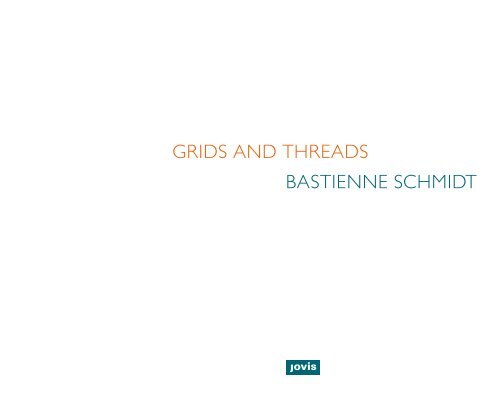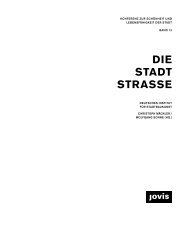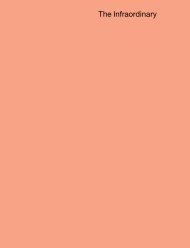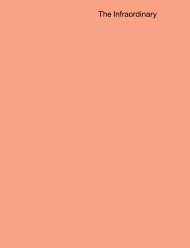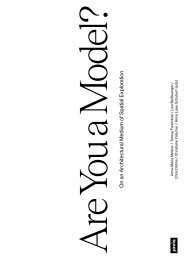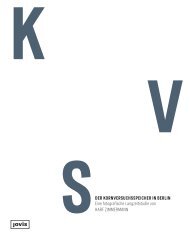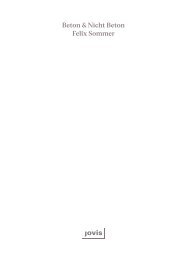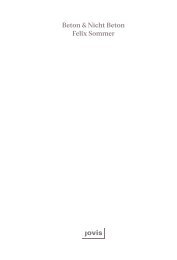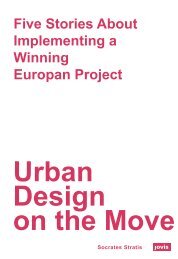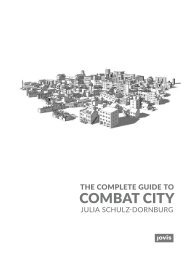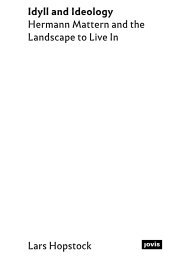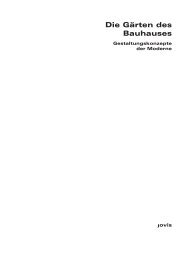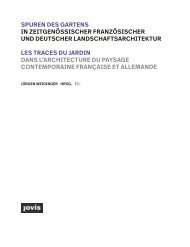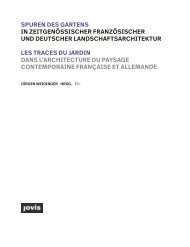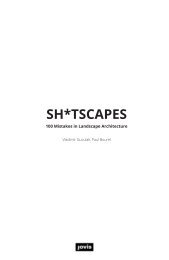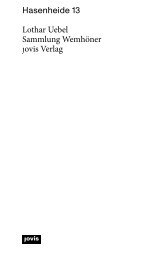Grids and Threads, Bastienne Schmidt
ISBN 978-3-86859-505-5 https://www.jovis.de/de/buecher/vorschau/product/grids-and-threads.html
ISBN 978-3-86859-505-5
https://www.jovis.de/de/buecher/vorschau/product/grids-and-threads.html
You also want an ePaper? Increase the reach of your titles
YUMPU automatically turns print PDFs into web optimized ePapers that Google loves.
GRIDS AND THREADS<br />
BASTIENNE SCHMIDT
Mapping with <strong>Grids</strong> <strong>and</strong> <strong>Threads</strong><br />
Terrie Sultan in Conversation<br />
with <strong>Bastienne</strong> <strong>Schmidt</strong><br />
TS In looking over the course of your career, one of the many things<br />
that st<strong>and</strong>s out is your comfort with many different mediums <strong>and</strong><br />
approaches to artmaking—photographs, drawings, painting, collage,<br />
<strong>and</strong> sculpture. Why do you work in so many disparate mediums?<br />
BS I have always been interested in the concept of duality of process.<br />
The idea of being boxed in to one medium, such as photography,<br />
painting, or installation never appealed to me. By using different<br />
mediums, I am speaking different languages <strong>and</strong> introducing new elements<br />
to add meaning to the process itself.<br />
TS You also move fairly seamlessly between representation <strong>and</strong><br />
abstraction. What is the connecting thread between these two artistic<br />
approaches?<br />
BS There are a few different things at play. One is my early fascination<br />
with photography, which pushed me towards representation. I was<br />
very interested in working to capture human emotions. But there was<br />
always a very strong geometric component in terms of composing the<br />
picture. I studied both painting <strong>and</strong> photography in Italy. When I came<br />
to the States, photography took precedence as a way to make a living.<br />
But I never made a clear distinction that one approach was artistically<br />
more important to me than the other. Painting <strong>and</strong> photography call<br />
for different languages, one is the language of abstraction <strong>and</strong> conceptualism,<br />
<strong>and</strong> the other is a language of humanism.<br />
TS That’s interesting because I find that even though the grid works<br />
have a basis in geometric abstraction <strong>and</strong> minimalism, there is nothing<br />
particularly austere about them. You have imbued them with a<br />
warmer, more human approach to that particular structure.<br />
BS For me, it is intriguing to look at the human touch within the grid.<br />
A computer-generated grid would not be of interest to me, because<br />
it is the little mistakes or imperfections that create that emotionality,<br />
a kind of sub-context in the work that makes it alive for me.<br />
TS Another element that strikes me here is your approach to what<br />
has been traditionally thought of as women’s work, such as sewing,<br />
weaving, <strong>and</strong> quilting, which you share with a number of artists, from<br />
Alan Shields, Sheila Hicks, to Steven <strong>and</strong> William Ladd. Do you think<br />
about that when you’re working?<br />
BS I do think about it, but I also liberated myself very early on. I<br />
don’t have to fit neatly into a box; I never did. Some of my approach<br />
to materials is grounded in my having lived in so many different<br />
countries—Greece, Italy, Germany, <strong>and</strong> the United States—<strong>and</strong> seeing<br />
how these types of “making” are viewed differently in different<br />
cultures. Growing up in Greece, I was always surrounded by poor<br />
materials—peeling paint, material scraps. And later, I was drawn to<br />
the Arte Povera movement for similar reasons. From all this I gained<br />
a recognition of beauty in imperfection. I’m a w<strong>and</strong>erer in between<br />
the mediums <strong>and</strong> between what artistic approach I use.<br />
TS Can we talk a little bit about erotica? Because some of the materials<br />
that you use here strike me as being very sensual.<br />
BS It would have never crossed my mind to think of the work that<br />
way. It’s certainly not conscious on my part. But I do care a lot about<br />
the tactile feeling of materials. I have memories of my mother making<br />
doll clothes <strong>and</strong> being comforted by the touch of the fabrics.<br />
TS Me too, that touch is comforting in a certain kind of way, but<br />
also a feeling of sensuality. And I have to say, I did find some of your<br />
compositions to be pretty suggestively erotic. Maybe that says more<br />
about the viewer than it does about the maker.<br />
BS Now that you say it, that’s what attracts me a lot in Eva Hesse’s<br />
work. Many of her shapes could be considered more female or erotic.<br />
But on the other h<strong>and</strong> her images could be read also as archetypical<br />
shapes that have been used for centuries.<br />
TS In this case, I am specifically thinking of the <strong>Grids</strong> <strong>and</strong> <strong>Threads</strong>
Threading Space<br />
Jacoba Urist<br />
In the emblematic 1913 work, 3 St<strong>and</strong>ard Stoppages, Marcel Duchamp<br />
rethinks one of the most fundamental aspects of physical reality: the<br />
distance between points on a line. Duchamp dropped three individual<br />
strings one meter long, from a height of one meter onto a set of<br />
horizontal planes. He then glued each piece of string to the canvas<br />
below in the shape of their fall, creating a curved tool of reference.<br />
If a thread, he said in the project’s instruction notes for replication,<br />
“twisting as it pleases,” retains the length of a meter, a new image of<br />
the unit exists. Both literal <strong>and</strong> ironic, the St<strong>and</strong>ard Stoppages undermines<br />
our rational assumptions of measurement <strong>and</strong> the world’s<br />
sense of scale becomes a kind of riddle: what exactly is an interval of<br />
space—if anything significant?<br />
Of course, Duchamp is probably known best for the tenet: It is my<br />
deed of making a selection that makes a work, a work of art. Surely,<br />
the Duchampian meter is an abstraction about dimension—as well<br />
perhaps, as the most readymade of readymades. The artwork, after<br />
all, is really only the smallest str<strong>and</strong> of fiber, hundreds upon thous<strong>and</strong>s<br />
of which occupy a person’s everyday existence without much of our<br />
thought or emotional energy. Blankets, sweaters, even the most<br />
ornate of textiles, often make up the singular, quotidienne moments<br />
of human existence. And thus, contemporary artists—particularly<br />
in the face of modern atrocities—have adopted fabric to evoke<br />
the universality of suffering. Piles of garments, whether the delicate<br />
snowsuits in Ai Weiwei’s Laundromat to the bright saris in Patricia<br />
Cronin’s Shrine for Girls, conjure a sense of collective responsibility <strong>and</strong><br />
personhood. And yet, the St<strong>and</strong>ard Stoppages are a deliberate, aesthetic<br />
reflection—beautiful, yes, in their concept as Duchamp would<br />
say—but also in their ordinariness <strong>and</strong> humility, slivers of filament on<br />
canvas, gr<strong>and</strong> in a sense of pure visual simplicity.<br />
So too is <strong>Bastienne</strong> <strong>Schmidt</strong>’s most recent series of conceptual photography<br />
<strong>and</strong> geometric figures—captivating in their concept <strong>and</strong><br />
their aesthetic integrity. Here, in her new monograph, <strong>Schmidt</strong> constructs<br />
a deceptively simple tableau of thread <strong>and</strong> string l<strong>and</strong>scapes,<br />
as well as a collection of systematic meditations on the power of<br />
white space <strong>and</strong> delicate boundaries. Taken as a whole, she is asking<br />
us to reflect on the arbitrariness of typology: how do artists <strong>and</strong><br />
architects bifurcate three-dimensional planes? Or as <strong>Schmidt</strong> once<br />
posed the question to me: how do we confirm spaces?<br />
Recently, William Eggleston reflected on the speed of his medium. A<br />
photograph is made so quickly, he said, like in a one hundredth of a<br />
second. Today, it is nearly impossible to view an image without a sense<br />
of that split-second motion, where the artist has taken decisive <strong>and</strong><br />
irreversible action. Unlike a painter, there is no stepping back for the<br />
photographer to possibly add looser, fuller brush strokes. More than<br />
any other art form, we bear witness to the flicker of creativity <strong>and</strong><br />
insight. Even so, as curator Charlotte Cotton describes in her book,<br />
the photograph as contemporary art challenges the particular notion<br />
of the artist foraging daily life, in search of that precise moment when<br />
a great visual appears in her frame. Instead, for the conceptual photographer,<br />
the language is the intent, manifest in each h<strong>and</strong>crafted<br />
effect <strong>and</strong> composition. As <strong>Schmidt</strong> put it once: the medium is the<br />
thought.<br />
In the first part of her book, <strong>Schmidt</strong> shows the world in both exaggerated<br />
<strong>and</strong> reduced perspective, building her installations from<br />
scraps of recycled fabric, twigs, <strong>and</strong> colored string, against the blank<br />
canvas of snow—as though there is no true sense of scale. She has<br />
captured the idea of space, rather than any of its tangible conditions.<br />
In this context, there seems to be an inner dialogue with American
artist Fred S<strong>and</strong>back. Although, because <strong>Schmidt</strong>’s thread installations<br />
are photographic, there is an additional layer of process, <strong>and</strong> her original<br />
artwork endures only a half-hour or so. Her images consider a<br />
reality that purposely ceases to exist, conflating the “real” <strong>and</strong> the<br />
manufactured world. But both artists, remarkably, delineate boundaries<br />
through a porous approach. A minimalist sculptor, S<strong>and</strong>back<br />
worked with elastic cord <strong>and</strong> vaguely fuzzy acrylic yarn to pose his<br />
own riddle in a sense: the illusion of volume without mass. S<strong>and</strong>back<br />
tightly secured thin lines of materials to the floors <strong>and</strong> walls<br />
of galleries, defining—<strong>and</strong> redefining—three-dimensional form in<br />
large indoor spaces. His work feels at once ephemeral <strong>and</strong> structural,<br />
almost as if the work of a magician who has managed to reinvent<br />
the depth of our physical universe. Interiors are elusive, S<strong>and</strong>back<br />
explained, you can’t ever see an interior.<br />
Still, <strong>Schmidt</strong>’s art is deeply rooted in the legacy of raw materiality <strong>and</strong><br />
everyday life. There is an underlying pragmatism to each photograph.<br />
One can’t engage her work without references to Arte Povera, the<br />
group of mid-century Italian artists known for their use of found<br />
objects <strong>and</strong> “poor man’s” materials, such as rope, rags, paper, <strong>and</strong> soil.<br />
In <strong>Grids</strong> And <strong>Threads</strong>, for instance, strings are left undone, frayed to<br />
achieve a sense of authenticity <strong>and</strong> transformation. For those associated<br />
with Arte Povera, fabric is also indispensable, but has a different<br />
role than it does for artists like Ai Weiwei <strong>and</strong> Patricia Cronin. At<br />
base, there is a visceral, pre-industrial quality to <strong>Schmidt</strong>’s installations.<br />
Like a painting or a sculpture, the maker’s h<strong>and</strong> is evident in each <strong>and</strong><br />
every photograph.<br />
The second part of <strong>Schmidt</strong>’s project—a set of mixed media works<br />
on Arches paper—focuses exclusively on a set of punched-out, 8 × 8<br />
square grids, achieving a woven sculptural result. These are not only<br />
quiet, monochromatic reflections on paper, rooted in the transcendent<br />
traditions of Agnes Martin, Lucio Fontana, <strong>and</strong> Robert Ryman,<br />
but also variations on minimalism <strong>and</strong> shape that become their own<br />
kind of spirituality. And it would be a mistake to approach the two<br />
halves of <strong>Grids</strong> And <strong>Threads</strong> separately: both reflect the delicate interplay<br />
of perimeter <strong>and</strong> restriction. In this world of saturated ownership,<br />
<strong>Schmidt</strong> has said, we stake a property, it is ours. While demarcations<br />
can certainly be momentous—consider the various ways<br />
people mark <strong>and</strong> honor the dead—they are fraught with problem-<br />
atic implications. In this way, <strong>Schmidt</strong>’s string constellations become<br />
reminders of the world’s fragility, of the national <strong>and</strong> private borders<br />
we maintain, both as physical realities (see her previous work Home<br />
Stills, about life’s domesticity) <strong>and</strong> as social constructs.<br />
<strong>Schmidt</strong> has described how the physicality of white <strong>and</strong> the permeability<br />
of paper allows shadows to “fall into the pieces.” As such, her<br />
grids directly engage with Fontana’s legacy of spatial concepts. His<br />
works—collectively known as ‘cuts’—blur our sense of a second <strong>and</strong><br />
third dimension, creating an illusion of depth. For his 1950s <strong>and</strong> 60s<br />
masterpieces, the artist punctured surfaces of canvas, slashing deliberate<br />
diagonal incisions with a sharp blade. I have constructed, he has<br />
said, not destroyed. But if Fontana obscures the distinction between<br />
painting <strong>and</strong> object, light <strong>and</strong> shadow, <strong>Grids</strong> And <strong>Threads</strong> presents a<br />
kind of fourth dimensionality, carrying his use of perforation into the<br />
realm of photography.<br />
Ultimately, <strong>Schmidt</strong> is asking her viewers three monumental questions:<br />
How do we keep space? How do we divide space? And how<br />
do our partitions separate <strong>and</strong> unite us? As Good Fences Make Good<br />
Neighbors, Ai Weiwei’s most ambitious public project to date, illustrates,<br />
borders have particular resonance at this historic juncture. His<br />
interventions—such as placing a gilded cage within the Washington<br />
Square Arch—pondered the political <strong>and</strong> social impulses we have<br />
to divide ourselves from one other. At the beginning of her career,<br />
<strong>Schmidt</strong> says she was much more interested in social documentary.<br />
But there is this ongoing dialogue now—a shared language, if you<br />
will—between her painting <strong>and</strong> her photography, areas <strong>Schmidt</strong> masters<br />
equally. White, Robert Ryman said in an interview, has a tendency<br />
to make things visible; you can see more of a nuance. And it is through<br />
this similar attention to color—<strong>and</strong> her bird’s-eye perspective—that<br />
at last, as with Duchamp’s meter, once again we see the universe for<br />
what it truly is: an exquisite, ironic riddle that can not be solved.
Untitled, 2014 –17<br />
Bridgehampton<br />
Chromogenic print<br />
Untitled, 2014 –17<br />
Bridgehampton<br />
Chromogenic print<br />
Untitled, 2014 –17<br />
Bridgehampton<br />
Chromogenic print<br />
Untitled, 2014 –17<br />
Bridgehampton<br />
Chromogenic print<br />
Untitled, 2014 –17<br />
Bridgehampton<br />
Chromogenic print<br />
Untitled, 2014 –17<br />
Bridgehampton<br />
Chromogenic print<br />
Untitled, 2014 –17<br />
Bridgehampton<br />
Chromogenic print<br />
Untitled, 2014 –17<br />
Bridgehampton<br />
Chromogenic print<br />
Untitled, 2014 –17<br />
Bridgehampton<br />
Chromogenic print
Untitled, 2014 –17<br />
Bridgehampton<br />
Chromogenic print<br />
Untitled, 2014 –17<br />
Bridgehampton<br />
Chromogenic print<br />
Untitled, 2014 –17<br />
Bridgehampton<br />
Chromogenic print<br />
Untitled, 2014 –17<br />
Bridgehampton<br />
Chromogenic print<br />
Untitled, 2014 –17<br />
Bridgehampton<br />
Chromogenic print<br />
Untitled, 2014 –17<br />
Bridgehampton<br />
Chromogenic print<br />
Untitled, 2014 –17<br />
Bridgehampton<br />
Chromogenic print<br />
Untitled, 2014 –17<br />
Bridgehampton<br />
Chromogenic print<br />
Untitled, 2014 –17<br />
Bridgehampton<br />
Chromogenic print
Untitled, 2014 –17<br />
16×20 inches<br />
Mixed Media on Arches Paper<br />
Untitled, 2014 –17<br />
16×20 inches<br />
Mixed Media on Arches Paper<br />
Untitled, 2014 –17<br />
16×20 inches<br />
Mixed Media on Arches Paper<br />
Untitled, 2014 –17<br />
16×20 inches<br />
Mixed Media on Arches Paper<br />
Untitled, 2014 –17<br />
16×20 inches<br />
Mixed Media on Arches Paper<br />
Untitled, 2014 –17<br />
16×20 inches<br />
Mixed Media on Arches Paper<br />
Untitled, 2014 –17<br />
16×20 inches<br />
Mixed Media on Arches Paper<br />
Untitled, 2014 –17<br />
16×20 inches<br />
Mixed Media on Arches Paper
Untitled, 2014 –17<br />
16×20 inches<br />
Mixed Media on Arches Paper<br />
Untitled, 2014 –17<br />
16×20 inches<br />
Mixed Media on Arches Paper<br />
Untitled, 2014 –17<br />
16×20 inches<br />
Mixed Media on Arches Paper<br />
Untitled, 2014 –17<br />
16×20 inches<br />
Mixed Media on Arches Paper<br />
Untitled, 2014 –17<br />
16×20 inches<br />
Mixed Media on Arches Paper<br />
Untitled, 2014 –17<br />
16×20 inches<br />
Mixed Media on Arches Paper<br />
Untitled, 2014 –17<br />
16×20 inches<br />
Mixed Media on Arches Paper<br />
Untitled, 2014 –17<br />
16×20 inches<br />
Mixed Media on Arches Paper
Biographies<br />
<strong>Bastienne</strong> <strong>Schmidt</strong><br />
is a multimedia artist working with photography, painting <strong>and</strong> largescale<br />
drawings. She was born in Germany, raised in Greece <strong>and</strong><br />
Italy <strong>and</strong> has lived in New York <strong>and</strong> Bridgehampton for the past<br />
25 years.<br />
Through photography <strong>and</strong> mixed media, she explores concepts of<br />
identity <strong>and</strong> place. Photography <strong>and</strong> art fall for <strong>Schmidt</strong> into the<br />
realm of archeology, exploring layers of history <strong>and</strong> meaning, <strong>and</strong><br />
reassigning value to them.<br />
<strong>Schmidt</strong> was born in Munich, Germany <strong>and</strong> moved at the age of<br />
9 with her family to Greece. She spent her childhood surrounded<br />
by her father’s archeological work, which instilled in her a desire<br />
to organize, map, <strong>and</strong> attempt to underst<strong>and</strong> systems through her<br />
artwork.<br />
Her work has been shown nationally <strong>and</strong> internationally in over 100<br />
exhibitions among them at the Watermill Center, the International<br />
Center of Photography in New York, the Brooklyn Museum, the<br />
New Museum, the Museum für Kunst und Gewerbe in Hamburg<br />
<strong>and</strong> the Southeast Museum in Photography in Daytona Beach,<br />
Florida.<br />
Her artwork is included in the collection of the Museum of Modern<br />
Art in New York, the International Center of Photography, the<br />
Brooklyn Museum, the Corcoran Gallery in Washington D.C.,<br />
the Victoria <strong>and</strong> Albert Museum in London, <strong>and</strong> the Bibliothèque<br />
Nationale in Paris among others. She has published 6 monographs,<br />
among them Vivir la Muerte, American Dreams, Shadowhome, Home<br />
Stills, Topography of Quiet, <strong>and</strong> Typology of Women. <strong>Grids</strong> <strong>and</strong> <strong>Threads</strong> is<br />
her seventh monograph.<br />
Public Collections<br />
Bibliothèque Nationale, Paris, France<br />
Brooklyn Museum, Brooklyn, NY<br />
Center for Creative Photography, Tucson, AZ<br />
Corcoran Gallery of Art, Washington, DC<br />
Guild Hall, East Hampton, NY<br />
The Heckscher Museum of Art, Huntington, NY<br />
International Center for Photography, New York, NY<br />
Museum of Fine Arts, Houston, TX<br />
The Museum of Modern Art, New York, NY<br />
Museum für Kunst und Gewerbe, Hamburg, Germany<br />
Museet Fotografiska, Stockholm, Sweden<br />
Margulies Collection, Miami, FL<br />
Norton Museum of Art, West Palm Beach, FL<br />
Parrish Art Museum, Watermill, NY<br />
Worcester Art Museum, Worcester, MA<br />
University of Texas, San Antonio, TX<br />
Victoria <strong>and</strong> Albert Museum, London, Engl<strong>and</strong><br />
www.bastienneschmidt.com
Terrie Sultan<br />
is Director of the Parrish Art Museum. She has more than thirty<br />
years of experience as a museum professional, serving in senior positions<br />
at the New Museum of Contemporary Art in New York, the<br />
Corcoran Gallery of Art in Washington, DC, <strong>and</strong> the Blaffer Art<br />
Museum at the University of Houston. She has organized numerous<br />
exhibitions featuring artists of national <strong>and</strong> international scope, <strong>and</strong><br />
authored some fifty books <strong>and</strong> exhibition catalogues. In 2003, she<br />
was awarded a Chevalier dans l’Ordre des Arts et Lettres by the Government<br />
of France.<br />
Jacoba Urist<br />
is an art <strong>and</strong> culture journalist in New York City. A regular contributor<br />
to The Atlantic, Jacoba covers long-form contemporary art <strong>and</strong><br />
architecture stories that often tackle larger social issues such as how<br />
artists should address human rights <strong>and</strong> the ways that 21st-century<br />
artwork can amend U.S. history. She has also published numerous<br />
art features in The New York Times <strong>and</strong> New York Magazine, as well as<br />
artist profiles <strong>and</strong> exhibition reviews for Cultured Magazine. In 2018,<br />
Jacoba was hired by the Smithsonian <strong>and</strong> Smithsonian Magazine to<br />
produce <strong>and</strong> write on the State Of The Arts, a series by the nation’s<br />
institution of cultural record that looks at the role of art <strong>and</strong> artists<br />
in a world that can feel perpetually in crisis.


